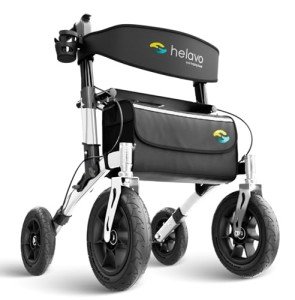An Intermediate Guide On Stable 4-Wheel Walker

The Stability of 4-Wheel Walkers: A Comprehensive Guide
A stable 4-wheel walker can change mobility for individuals experiencing obstacles with balance and coordination. These devices, frequently called rollators, can be vital tools in gaining back self-reliance for those recuperating from surgical treatment, overcoming age-related limitations, or handling chronic conditions. This blog explores the features, benefits, and factors to consider one should keep in mind when choosing a 4-wheel walker, supplemented with beneficial tables and a Frequently Asked Questions (FAQ) section to boost understanding.
Why Choose a 4-Wheel Walker?
A 4-wheel walker uses several advantages over conventional walking help, such as walking sticks or walkers with just 2 wheels. Below are a few of the crucial benefits:
Benefits of a 4-Wheel Walker
| Advantage | Description |
|---|---|
| Improved Stability | The four wheels supply a stable base, enabling simpler navigation across various terrains. |
| Improved Mobility | The designs are usually lighter and much easier to maneuver, permitting users to move with confidence. |
| Integrated Sit-Down Feature | Lots of 4-wheel walkers come with a built-in seat, providing users the alternative to rest when needed. |
| Storage Options | The majority of walkers consist of storage bags or baskets for individual items, increasing liberty for users. |
| Adjustable Height | Lots of models provide height changes to accommodate numerous user heights, providing convenience during use. |
| Braking System | A lot of walkers come equipped with hand brakes, allowing the user to safely stop and lock the walker in location. |
Kinds Of 4-Wheel Walkers
4-wheel walkers been available in numerous designs and functionalities to deal with various user needs. Below is a categorized table:
| Type | Description |
|---|---|
| Standard Rollators | Basic designs created for basic mobility. Typically lightweight and foldable. |
| Heavy-Duty Rollators | Models constructed to support larger weights (up to 500 pounds or more). Perfect for heavier users. |
| Double Brake Rollators | Offer both hand brakes and parking brakes for boosted security, particularly useful for elderly users. |
| Folding Walkers | Compact models that easily fold for transport and storage. Perfect for those who take a trip or have restricted area. |
| Specialized Rollators | Geared up with unique features such as integrated lights, larger seats, or specific designs for particular conditions like arthritis. |
Key Features to Consider
When selecting a stable 4-wheel walker, it is essential to pick a design that fits the user's needs. Here are some important features to think about:
- Weight Capacity: Always inspect the optimum weight limit.
- Height Adjustability: Ensure that it can be adapted to fit the user's height.
- Wheel Size: Larger wheels offer much better capability over rough terrains, while smaller wheels are great for indoor use.
- Seat Height and Comfort: If the design includes a seat, inspect its height and cushioning.
- Braking Mechanism: Look for reliable brakes that are easy to operate.
- Reduce of Folding: Users need to quickly fold and unfold the walker for transport.
- Storage Solutions: Evaluate storage choices like seat pouches and under-seat baskets.
- Material and Durability: Consider walkers made with durable materials to ensure durability.
Popular Models on the Market
Here's a selection of popular designs currently readily available, showcasing their unique features and specifications:
| Model | Weight Capacity | Seat Height | Features |
|---|---|---|---|
| Drive Medical Nitro | 300 lbs | 23.5" | Lightweight, easy-to-fold design, big wheels. |
| Medline Ultralight | 300 lbs | 23" | Integrated seat, adjustable handles, storage pouch. |
| Nova Zoom 4 | 300 lbs | 22-24" | Dual brakes, padded seat, easy to fold. |
| INFANT JOY 4-Wheel | 300 lbs | 20-23" | Lightweight aluminum frame, storage basket, ergonomic manages. |
How to Use a 4-Wheel Walker
Learning how to utilize a 4-wheel walker effectively is essential for maximizing security and mobility. Here's a step-by-step guide:
- Position the Walker: Stand behind the walker, with the handlebars at hip height.
- Change for Comfort: Make sure the height suits your comfort for standing and walking.
- Engage Brakes: Before sitting, engage the brakes to ensure the walker does stagnate.
- Step Forward: Move the walker forward, guaranteeing all four wheels touch with the ground.
- Walk Naturally: Use a natural walking rhythm, moving the walker forward and stepping the system as needed.
- Rest: When tired out, find a seat on the walker, engage the brakes, and sit conveniently.
FAQ
1. What is the perfect height for a 4-wheel walker?
- The handlebars should be at waist level when the individual is standing directly. A lot of walkers offer adjustable heights to accommodate this.
2. Can a 4-wheel walker be utilized outdoors?
- Yes, numerous models are developed for outdoor usage, featuring larger wheels for better navigation over uneven surfaces.
3. How do you keep a 4-wheel walker?
- Frequently check the wheels, brakes, and frame for wear and tear. find more info to get rid of particles, and make sure the brakes work correctly.
4. Are there insurance advantages for acquiring a 4-wheel walker?
- Numerous insurance strategies cover walkers if recommended by a doctor. Constantly check your particular plan information.
5. What is the average cost of a 4-wheel walker?
- Expenses may differ extensively, from around ₤ 50 for fundamental designs to over ₤ 300 for advanced designs.
A stable 4-wheel walker can substantially add to an individual's mobility, confidence, and quality of life. By considering the features, types, and perfect usage techniques discussed above, individuals can make informed decisions that best match their needs. Whether it's for healing, aging, or managing ongoing health conditions, choosing the ideal walker can result in a much healthier and more active lifestyle.

